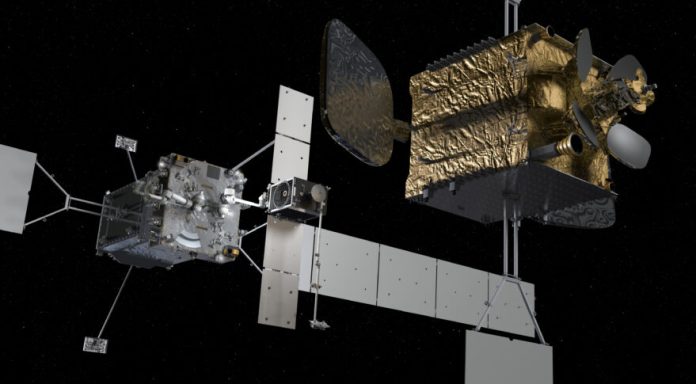Northrop Grumman today has two Mission Extension Vehicles in orbit providing station-keeping services for two Intelsat geostationary satellites that were running low on fuel.
The company meanwhile is preparing to launch a new servicing vehicle equipped with a robotic arm that will install propulsion jet packs on dying satellites.
Six still-undisclosed customers have signed up to get their satellites serviced by the Mission Robotic Vehicle, projected to launch in 2024, Joe Anderson, vice president of operations and business development at Space Logistics, told SpaceNews.
The MRV is the second generation servicing vehicle from Space Logistics, a wholly owned subsidiary of Northrop Grumman. It combines the company’s Mission Extension Vehicle (MEV) that is performing commercial operations with a robotic payload developed by the Defense Advanced Research Projects Agency.
DARPA is sharing its robotic arm with Space Logistics under a partnership that allows the company to use the technology for commercial and government satellite servicing in the geostationary belt.
“We will be demonstrating some robotic capability for government through the performance of our commercial missions,” Anderson said.
The primary commercial mission of the MRV is to install small propulsion devices known as mission extension pods. One of these units is inserted in the back of a client satellite propulsion system, adding six years of life to most geostationary satellites, he said.
The six customers have signed term sheets for seven mission extension pods, Anderson said. Once contracts are firmed up the company will be able to disclose their names.
The first MRV launch in 2024 will carry three pods. “With these six customers, the MRV manifest is currently filled through mid-2026,” he said. The MRV is expected to have a 10-year service life. Space Logistics is projecting to install five to six mission extension pods per year, Anderson added. “We are planning to launch the second set of MEPs in early 2025.”
The installation of MEPs or other devices is likely to become the primary purpose of the MRV. But Northrop Grumman also is looking for opportunities to perform other services like detailed inspections, relocations of client vehicles or simple repairs such as releasing a solar array that is stuck or an antenna that doesn’t deploy properly.
Anderson noted that the commercial MEVs can perform more than just docked station keeping like what they are now doing for Intelsat. They can also dock with satellites in inclined orbit and reduce their inclination, relocate satellites to other orbits or perform remote inspections using light detection and ranging (LIDAR) sensors.
DARPA and Space Logistics recently completed a preliminary design review of the MRV and this week are reviewing the mission extension pod at the company’s assembly facility in Dulles, Virginia.
Because the robotic arm was developed with Defense Department funding, DARPA expects Space Logistics to show the “potential benefit of having a persistent servicing capability in GEO orbit that can serve the needs of the U.S. government through commercial contracts with us,” said Anderson.
He said Space Logistics already has booked a launch vehicle for the first MRV mission but the contract has not yet been announced. The company’s MEV-1 launched in October 2019 on an International Launch Services Proton rocket. The MEV-2 launched in August 2020 on Arianespace’s Ariane-5. The MRV which carries a U.S. government-designed payload has to launch on a U.S. rocket.
Servicing satellites in low Earth orbit
Northrop Grumman is focused on geostationary satellite servicing but sees a future market in low Earth orbit.
Orbit Fab, a startup that developed an orbital propellant tanker and a fueling port for satellites, announced Sept. 7 that both Northrop Grumman and Lockheed Martin are investing in the company.
“The LEO market is quite a bit more diverse than the geosynchronous,” said Anderson. Satellites in LEO are smaller and cheaper so servicing or refueling might not be economical, he said. But for higher value assets, extending the service life would be worth considering.
NASA and Maxar Technologies are developing the On-orbit Servicing, Assembly, and Manufacturing 1 (OSAM-1) to robotically refuel the Landsat 7 imaging satellite.
Not all low-flying satellites are disposable, Anderson said. The U.S. government will be launching expensive satellites that will benefit from servicing, he said.
Beyond the MRV, Space Logistics is eyeing a third-generation system focused on refueling, said Anderson.
That market will grow as more satellites are designed and built with refueling and docking ports. “The satellites we are servicing today were launched 20 years ago and were not designed to be refueled. So looking forward into the future we see refueling as a very good market. There is great demand and interest from our customers, especially on the military side. The want to add refueling interfaces on spacecraft. And so that’s why we invested in Orbit Fab.”
Both Northrop Grumman and Lockheed Martin are actively working to shape the standard refueling interface that would help create a market for gas stations in space.
Anderson said the U.S. Space Force and the Defense Innovation Unit are funding programs to add fueling ports to satellites. “So there’s definitely interest from the U.S. government in those capabilities.”
Rick Ambrose, executive vice president of Lockheed Martin Space, told SpaceNews that the company is motivated to invest in servicing technologies like Orbit Fab’s because customers are pushing the industry in that direction.
Setting standards for docking and refueling ports will be critical, he said. Once the industry agrees on a common standard, the market will boom. Space should be like the internet, Ambrose said. “If you don’t comply, you don’t get to play.”
– Advertisement –
